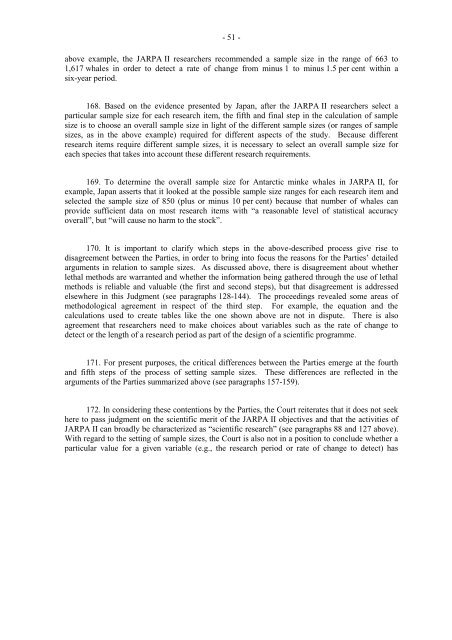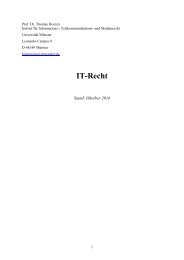3d4yVkKMl
3d4yVkKMl
3d4yVkKMl
You also want an ePaper? Increase the reach of your titles
YUMPU automatically turns print PDFs into web optimized ePapers that Google loves.
- 51 -<br />
above example, the JARPA II researchers recommended a sample size in the range of 663 to<br />
1,617 whales in order to detect a rate of change from minus 1 to minus 1.5 per cent within a<br />
six-year period.<br />
168. Based on the evidence presented by Japan, after the JARPA II researchers select a<br />
particular sample size for each research item, the fifth and final step in the calculation of sample<br />
size is to choose an overall sample size in light of the different sample sizes (or ranges of sample<br />
sizes, as in the above example) required for different aspects of the study. Because different<br />
research items require different sample sizes, it is necessary to select an overall sample size for<br />
each species that takes into account these different research requirements.<br />
169. To determine the overall sample size for Antarctic minke whales in JARPA II, for<br />
example, Japan asserts that it looked at the possible sample size ranges for each research item and<br />
selected the sample size of 850 (plus or minus 10 per cent) because that number of whales can<br />
provide sufficient data on most research items with “a reasonable level of statistical accuracy<br />
overall”, but “will cause no harm to the stock”.<br />
170. It is important to clarify which steps in the above-described process give rise to<br />
disagreement between the Parties, in order to bring into focus the reasons for the Parties’ detailed<br />
arguments in relation to sample sizes. As discussed above, there is disagreement about whether<br />
lethal methods are warranted and whether the information being gathered through the use of lethal<br />
methods is reliable and valuable (the first and second steps), but that disagreement is addressed<br />
elsewhere in this Judgment (see paragraphs 128-144). The proceedings revealed some areas of<br />
methodological agreement in respect of the third step. For example, the equation and the<br />
calculations used to create tables like the one shown above are not in dispute. There is also<br />
agreement that researchers need to make choices about variables such as the rate of change to<br />
detect or the length of a research period as part of the design of a scientific programme.<br />
171. For present purposes, the critical differences between the Parties emerge at the fourth<br />
and fifth steps of the process of setting sample sizes. These differences are reflected in the<br />
arguments of the Parties summarized above (see paragraphs 157-159).<br />
172. In considering these contentions by the Parties, the Court reiterates that it does not seek<br />
here to pass judgment on the scientific merit of the JARPA II objectives and that the activities of<br />
JARPA II can broadly be characterized as “scientific research” (see paragraphs 88 and 127 above).<br />
With regard to the setting of sample sizes, the Court is also not in a position to conclude whether a<br />
particular value for a given variable (e.g., the research period or rate of change to detect) has



